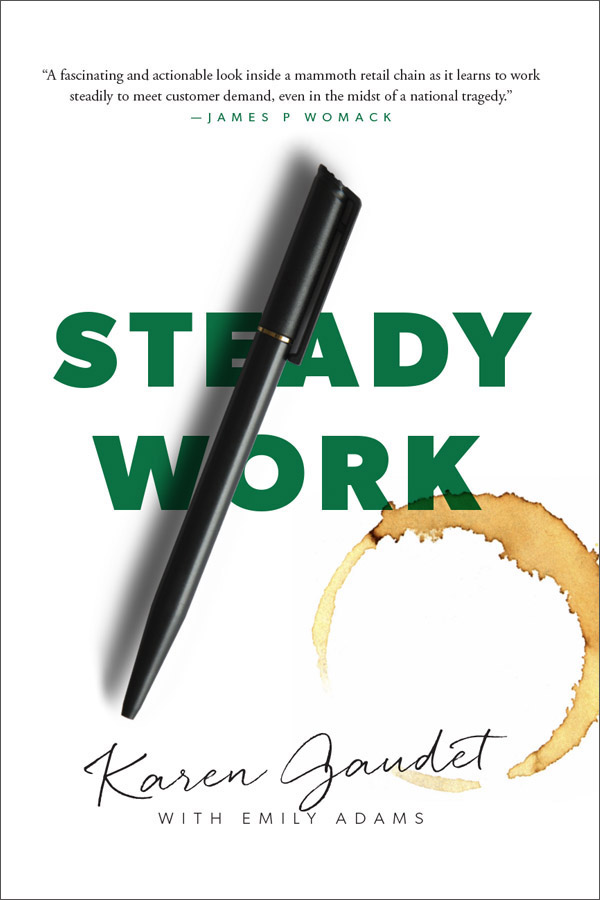I learned the hard way while developing an approach to spreading a Lean Operating System across my more than 100 café locations at Starbucks Coffee Company.
Before there was Lean Thinking and practice at Starbucks there was the era of rapid best practice sharing. During those years of high growth, we found ourselves readily applying best practices to solve common problems. I myself fell victim to the addictive nature of it all.
The solutions that others had developed garnered a nice, fast result. When moving fast and furious in the retail industry, solutions that take the edge off the distance, the distance between having a problem and getting a result can feel like a godsend. The time frames are short and the work demanding, there is high volume and high variation in mix. It is a short distance between you and the paying customer. Lead times are very short, three minutes short in fact. Particularly when results are being ranked and stacked through spreadsheets for executives to make decisions.
The results on the spreadsheets representing the condition of work, service experience, and business, are viewed daily by every leader and executive in the organization to include the CEO and the phone call that would come if there was an identified gap in results….a problem.
We assumed that what worked for one leader or café that had a problem must work in the next. But then the same issues would continue to come up, people became frustrated, and the business lost time, money.
We assumed that what worked for one leader or café that had a problem must work in the next. But then the same issues would continue to come up, people became frustrated, and the business lost time, money. Upon closer examination I realized the “power” of practicing something lies inside, like a seed, waiting to be watered and nurtured, a seed that represents a person’s thinking.
The thinking must be practiced.
I am suggesting that through rapid deployment of other’s best practices, we rob people of the very thinking needed to build the capability to sustain excellent results.
Through the act of thinking; which calls on you to practice, test your hypothesis and measure the result, we develop understanding that enables sustainable solutions. I found that this cannot be derived through rapid deployment of other’s thinking. By first understanding the problem, developing your own thinking about the problem, and testing out the proposed solution; must be a pre-work to the application of any shared best practice.
In business, to grow is often essential in order to stay in business. Growth comes in many forms: growing the size of business, decentralized operation to/from centralized operation, innovation in product and services, and possibly even growing by doing less. I have found it is harder to stay focused over time vs. seemingly easier to satisfy the need for immediate gratification. An internal rate of return is different than a return on investment.
When leading growth across a large and dispersed business the tendency to copy and paste solutions to problems that get in the way of growth runs high. I mean who doesn’t want one less thing to have to figure out or struggle to understand? If we can get the result much faster by having everyone do the same thing, why would you not want a faster better financial result? But wait a minute do you really? How do you know?
I’ve witnessed a virtual epidemic of people pushing ‘best practices’ as a means of tackling problems. The challenges in developing capable future talent for the organization is also a gap of significant proportions. What is the capability most sought after in future business leaders? If you guessed critical thinking and problem solving, you would be right! Let’s look at how one example plaid out.
When leading growth across a large and dispersed business the tendency to copy and paste solutions to problems that get in the way of growth runs high. I mean who doesn’t want one less thing to have to figure out or struggle to understand?
While in my role of Regional Director of Operations one District Manager was the leader for ten locations in a specific geographical area. This district had one particular location that is not selling enough of a newly launched pastry. This new pastry launched with high expectations represented on the financial plan. The VP, Regional Manager, District Manager and Café Manager have a yearly financial bonus and yearly performance review tied to the successful launch of new products. This all makes great sense on some level.
One of the locations that was lagging in sales decided to give a free sample of this new pastry to everyone who entered the café who ordered a beverage. This action resulted in significant growth in sales of this pastry and was recognized as a Best Practice.
The District Manager was excited to see such results and directed each location to do the same. The District Manager made sure each location tracked the sales of the pastry closely on a visual board outside of the manager’s office. This tracking chart was completed by the café manager who would extract data on the pastry line from a sales report and then record this information on the chart. Looking into a sales report pulling out the specific pastry line and recording this information on the chart that was posted. This took about 30 minutes every morning. The District Manager requested each of the locations continued to do the same. In order to do this sampling, each location prepared the samples multiple times a day, cut up the pastry and placed them into individual small paper cups. Each location also staffed a team member to hand out the samples to every customer each day during their busiest time periods. In total this added up to about an additional 2 labor hours a day with an average wage of $11.00 per hour, at each of the 10 Cafés.
The District Manager also shared this one stores result with his Regional Manager. The Regional Manager was so impressed by the results that they asked asked each of the other nine District Managers to do what the first District Manager had done to drive the sales of the new pastry.
The Regional Manager was so impressed on the Monday morning leadership call he shared with the other nine Regional Managers about the one store performance on this pastry. All of the Regional Managers then directed each of their Ten District Managers to do the same.
Outside of two weeks we have 1000 locations………… performing the best practice developed to solve the sales problem of a newly launched pastry that was identified in one location.
Only upon reflection we began to realize that this “best practice” was in fact anything but optimal. The overall result across the VP area of responsibility of 1000 locations was actually a lower profit contribution on the new product and because of this, the product was then cancelled for not meeting its financial expectations for the business.
“When we began to examine this practice in more detail, we learned that this ‘best practice’ in fact had significant drawbacks.
The sampling slowed down the overall service experience and thus the cafés could not process as many transactions during their peak sales period in the time needed.
The frustrated customers ended up not ordering their normal breakfast sandwich because service was taking too long and the average ticket for many transactions went down.
At the end of the day the total overall result was a loss. All of the product design, planning, marketing, supply chain development etc. was a loss.
“Best Practices” are developed by people solving for a particular problem. They have done the hard work of trying to understand all the finer details of a specific problem. They have likely tested different applications of the practice and can predict the outcomes. Through this they have developed an understanding of what to do to improve to the next level and or grow.
We learned an essential lesson about the hazards of trying to identify and then replicate so called “best practices”.
“Best Practices” are developed by people solving for a particular problem. They have done the hard work of trying to understand all the finer details of a specific problem. They have likely tested different applications of the practice and can predict the outcomes. Through this they have developed an understanding of what to do to improve to the next level and or grow.
They have developed and applied their “Best Thinking”.
The difference in my mind between sharing a best practice (solution) to sharing best thinking (method to problem solving) is greater capability developed in the people.
All of this leading to greater business results.
Looking back at the above example, the leader of the manager does not have the finer details of the situation, and is simply directing all the other locations to apply the “Best Practice” without actually asking them for their “Best Thinking.”
The leader assumes that all of the other locations have the same problem because there are gaps in financial performance or there are pieces of similar problems happening across many locations.
It is easy to falsely see Best Practice and Best Thinking as the same thing however give the manager a method or approach to thinking and he/she can solve any problem that shows up.
Why does it matter how all of this links to the foundational component of Lean Thinking of stabilizing the operation through developing standardized work? We discovered through our addiction to spreading and enforcing the application of best practices a significant capability gap in the people who needed to be solving the most critical business problems. We found managers and others waiting around for the next best practice to be shared vs. trusting in their own capability to solve the problems in their business.
Lean Operating and Management systems are grounded in developing standardized work that connects one process to the next. The purpose of standardized work is to provide a foundation for improvement, stability. This is developed with a keen understanding of Takt Time, which is in a sense the voice of the customer. Takt time is calculated by taking the number of units/ products required to deliver to the customer and divide that by the amount of time available to produce those products. Two other key required aspects of standardized work include work sequence and standard inventory (in process).
The steps or work elements are then set up by operator to Takt (work sequence). Then the next set of work elements for the next operator in the process and so on. Grounded in solid problem solving.
The standardized work (the current best-known way to do this particular work) by all who perform it; becomes the basis on which to now improve by solving the problems that become visible. The standardized work is then updated as improvements in how to perform the work are developed by solving the problems.
Best Practices then are solutions that have been developed by one person or team to solve for a particular problem that has delivered a positive result and then applied system wide across a business.
So, what is the challenge of spreading best practices across the system?
Any one best practice fails to consider if the same problem it solves for in one location exists in each of the locations it is being applied to.
This is what leads me to offer an alternative approach and that is to share “Best Thinking”.
“Best Thinking” is the method of thinking, that actually developed the solution to the original problem. Along with the thinking comes the ownership/identification of the person to achieving the results. There is no shortcut to sustainment.
To share the “Best Thinking” each person in the organization needs to understand and practice asking a few simple yet effective questions. These questions come from the leader going to the Gemba ( the place in which the work is happening) to understand the work. Some practiced questions might be “What did you consider when observing this problem?” How often did the problem show up when you observed the work being performed” Has the problem shown up at different times of day, with different people or is it isolated in some way? How is this problem measurable and observable?” “What facts do we know about this problem?”
We are then committing to developing the capability of the people, not making assumptions that we know and understand the problem. We will produce a much better result in the process, that is sustainable.
Sharing best practices had become a prevalent approach to solving problems across the enterprise. This proved to be a challenge for sustainability as those who simply took others best practices had not developed the thinking and problem-solving capability and the results did not sustain.
You may see this as obvious or say “of course”.
The next time you find yourself sharing a solution developed by someone else, first ask the critical question “Is the problem the same? How do you know? Have you observed the problem in the same way? What will be lost by not requiring each leader to take responsibility, demonstrate Best Thinking and facilitate their own best solution to the assumed same problem?
This article is adapted from Karen’s new book Steady Work, which is now available for sale in the LEI bookstore. Buy your copy here.







